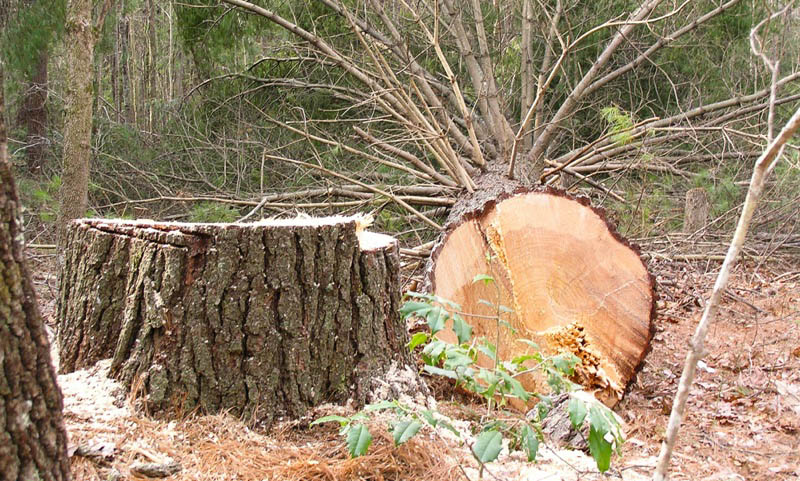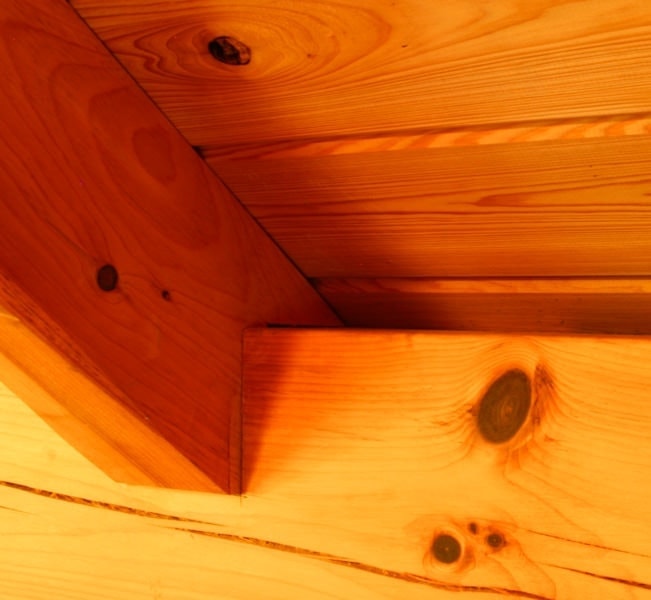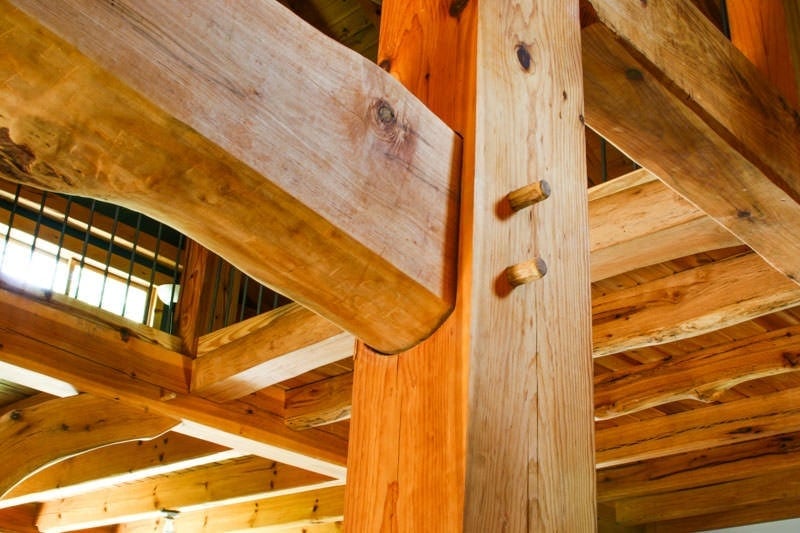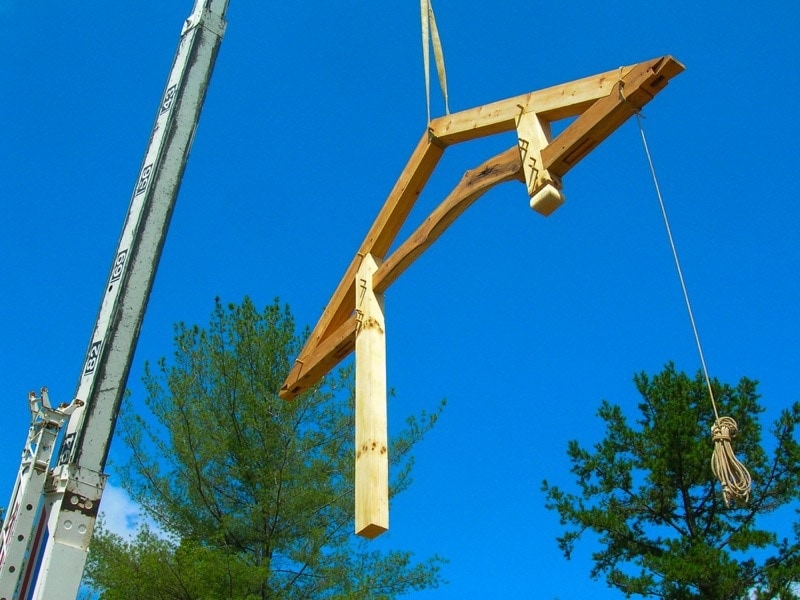I often get asked if it is okay to use green, or freshly cut timbers, for a timber frame. In fact, most of the frames that go up today are cut and raised without going into a kiln or going through the process of being air-dried. Before the advent of kilns to dry the wood, all of the timber frames (for thousands of years) have been green or air-dried, with most green timbers. So, which is best: green vs. dried timbers?

- Air-drying is by far the cheapest and easiest way to dry timbers. You are not using energy except for what the sun gives you. However, the catch is that, on average, it takes about a year per inch to dry. So if you have an 8×8 post, it would take 4 years to dry all the way through, and, depending on where you are, it may not be able to get below the 19% range.
- Traditional kilns that dry the majority of the conventional framing, siding, and trim can be used to dry timbers effectively. However, they have to be used at a low temperature for weeks to really do an effective job. Unfortunately, this uses quite a bit of energy and therefore costs money. If done too fast, it may cause the outside to dry too fast, leaving the inside with too much moisture.
- Radio frequency kilns are the best choice for kiln drying timbers. There are only a couple of them around, and therefore drying timber this way is very expensive. They work like a microwave oven, which basically dries the timbers from the inside out.
- Reclaimed wood is dry by its nature – timbers standing for many decades as a built structure are often the driest timbers available. But the reclaimed timbers themselves are often pricey. And it’s a look that may not be for everybody: because the beams are usually irregular, twisted, and non-square, they must be hand-scribed to connect, which adds to the labor cost. But if you like a weathered look, the result is a beautiful, artistically rustic structure.

- In post and beam situations, move the pegs closer down to the bearing surface between the post and beam. This will allow the beam to stay closer to the bottom of the housing in the post over time.
- Where a housed rafter dives into a plate, cut an extra 1/8” off the bird’s mouth so the rafter will always bear on the housing and not the rafter tail.
Green timber is more likely to develop checks (splits and cracks from uneven shrinkage in the beam) than dried timbers. But checks add to the frame’s rustic beauty, and they are rarely a structural issue. Checks start to form on the exterior surface of timber when the beam shrinks as it dries. The crack usually stops at the center of the timber- if a crack continues all the way through a beam it would more than likely be a concern as far as the structural integrity.
Different species of wood shrink to different degrees. But they all shrink more than you might expect! Probably the most common species used in the U.S. is Douglas Fir. If you take a green Doug Fir timber and dry it to a moisture content of 8%, it can be expected to shrink almost 5% in size. Western Red Cedar doesn’t shrink quite as much: The same timber in Western Red Cedar timber would shrink a bit less, about 3%. In contrast, White Oak can be expected to shrink almost 6%.
Working with Green Timbers
So, what are some ways to minimize problems when you use green wood in your timber frame project? Number one, use free-of-heart-center timbers instead of the boxed heart. FOHC means that the timber is cut completely outside of the “bullseye” of the growth rings, and since all the growth rings are severed, the timber dries more evenly. Boxed Heart timbers retain moisture in the inner growth rings, and as the outside dries, shrinkage creates surface tension, which causes checks.
Another way to get the most out of your green timbers is to apply a wax-based sealer to the end grain. This forces all drying to occur out the timber’s sides and slows the drying process, which helps to discourage checks. One good product for this is Liquid Wax End Sealer from Heritage Natural Finish. Another product folks use for this purpose is Anchorseal.
There are some schools of thought that consider when the trees are harvested to affect the timbers’ stability during the drying process. The recommendation is to harvest trees in the fall, cut joints over the winter, and raise the frame in early spring. Enclose the frame over the summer so that by the next fall, when you completely enclose and air condition space, the timbers will be more stable due to a slower drying process.
What is Blue-Stained Wood?
Blue-stained logs and timbers used to be considered damaged goods. However, in recent years blue-stained timbers have seen a huge increase in popularity. So what is blue-stained wood? It is lumber (usually a pine species) with microscopic fungi in its sapwood of a tree. Blue-stained wood is often harvested from trees that have died from a bark-beetle infestation. They are harvested while they are still standing. Since the trees being harvested are already dead, this is a very ecologically-conscious type of timber to use.
According to the Southern Forest Products Association, the only impact on the wood is the color, and the fungi do not cause structural issues or pose any kind of health risk. But to many people, the unique coloration adds a beautiful element to a timber frame.
What and How to Store and Dry Your Own Timbers
Living trees contain large quantities of water. After the tree is cut and the wood begins to dry, the moisture that remains in the wood tends to equalize with the surrounding environment’s relative humidity. If you handle, dry, and store your green wood properly, you can minimize moisture content changes that might occur after your frame is built.
Usually, if the frame is fabricated at a similar moisture content that it will face after installation, no significant dimensional changes. I the frame is designed properly, some minor dimensional changes can be tolerated. Most lumber for timber frames should also be dried to an average moisture content of 15%, not to exceed 19%.
- Where to Store Your Timbers: The best place to stack your timbers is away from direct sunlight and out of the weather. A covered structure is best, although it does not need to be climate controlled.
- Create a Proper Base for Your Timbers: Build a foundation for your green timbers with timber already dry. Make sure the base is flat and level. Lay out cross pieces every 12” to 24” (depending on the beams’ size). The cross pieces (called stickers) need to all be the same thickness.
- Pile Your Timbers: Lay your timbers out on the stickers, which should be at right angles to the timbers. Put the biggest timbers or slabs at the bottom of the pile. Keep the weight of the lumber evenly distributed. You want all your stickers to line up vertically with the ones below to support the weight evenly. Once all the lumber is stacked, put some more stickers across the top and add some more weight on top.
- Keep Your Timbers Out of the Weather: You want the drying process to be a slow one. You don’t want direct sun or rain on your lumber. Protect it from wind and rain, and if necessary, protect it from the wind as well. You want to encourage air circulation – so if you lay metal roofing or a tarp over the stack, make sure there is some air space in between.
- Keep an Eye on the Moisture Content: It simply takes time for the wood to dry. Temperature and humidity are the critical elements in determining how slow or fast the process will be. Use a moisture meter to help you monitor the moisture content. Before you begin to cut the frame, it’s a good idea to store the lumber in your shop for a couple of weeks.
There are so many variations in the timbers that are used for framing. That is a part of what makes the craft of timber framing much like an art form. When you are deciding whether to use green or dried timber, new or reclaimed timbers, or timbers with blue stain, the main criterion should be the final aesthetic you want from your frame.
In the end, the choice will be up to you to decide on whether or not your timber is dried or left green. For my personal timber frame projects, I chose to go with green timbers and have not regretted the decision. Timber frames have certainly stood the test of time before the advent of the kilns.


Some of my neighbors are building a cabin up in the mountains. I heard them discussing the other day about whether they should use green wood or dry timber. It’s very interesting that there are different species of timbers.
We have a large yard full of White Oak timbers of many widths and lengths that were cut to build a timber frame home. The project fell through and the timbers have been air drying for 13 years. We are planning on selling them and wonder if the air drying of all those years adds an extra value to them? I take it that it is an uncommon situation as I can’t find any info that would help figure out the value.
Would greatly appreciate any advice! Thank you!
It can add value and character to the wood but it will depend on how they were stored. They will likely need some work done to them before use but aired dried white oak timber are worth something more than green timbers. If they don’t have any sapwood and it is all heartwood then the boat building industry may pay the most.
Thank you for your response to my wife.
The timbers in question amount to about 41,000 board feet; around 90% white oak, the rest red oak. Some are cut (for a frame the was canceled), the rest are uncut. Sizes range from 4×6 to 14×14, lengths from 12 feet to 16 feet. Most have the usual checks and shakes one would expect from air drying; some (obviously cut from tension wood — grr…) are bowed, some twisted, some both (invariably the smaller dimensions). Sap wood is “frassing” (as the Brits say), but when draw knifed and brushed the heart wood is sound (in Europe this is not considered a defect — I cut a Medieval frame — scribed — with timbers recycled from the canceled frame; the “wavy” edges add some “olde world” charm to it). Anyhow, the big question is what is the market value of the “well seasoned” oak timers? They were got green at around $1.00 per board foot a little over 13 years ago. I’ve seen sites offering “reclaimed” and “vintage timbers” averaging $4.50 per bf (or more). So, the question is, in your opinion, what would be a fair asking price for them?
I am not the best guy to talk to. Let me reach out to some folks tomorrow and see what I can find out for you.
Thank you.
I am sorry to be somewhat rhetorical, but your request price would be the price that the top purchaser would offer. There are too many variables, like did you elevate your timbers to dry, did you already mill them, have a cover over your timbers, did you use at least 1″ stickers, was there any infestation during drying, any mold, how will the timbers go from your place to the next place. Unless your timbers are already milled, you may find that you would need to pay somebody to remove them, so you may be better to just cut, split, stack, and keep your winter warm via your woodstove.
How long after timbers are cut til they really start to move on you? We are cutting white oak timbers for a frame this fall and hope to put it up early spring in Nebraska. Once they’re milled and joints cut are they going to move too much over the winter to put together?
They can start to move as soon as you cut them. I would end seal the timbers asap with Anchor Seal and then stack them up with stickers and the heaviest timbers up top.
Where are you located?
I live in North Carolina and I can’t get timber from my property approved to build with unless it is below the 19%. I plan to build a kiln to dry my timbers in to speed up the process. Is it better to rough cut the timbers to dimension before drying or dry the log and then cut to rough dimensions? I know that the timber will shrink a bit during the drying process but I figured if I leave enough excess in each direction it will get me close to where I can dimension it to actual size.
Hummmm, I would challenge them on 19% and see where that number came from. Also, where in NC? I would recommend full size before drying and then milling them down to their final size in case they move during drying. You can also get an engineer to look at the frame and stamp them for greenwood use, that would supersede you local code office. Let us know how we can help.
I live up in the mountains in WNC. In the residential code that ungraded lumber can be used but the way its written, its kind of confusing.
“Question:
Can ungraded lumber be used if the lumber is cut from the homeowner’s site?
Answer:
Yes, as an alternate material and method according to Section 105 of the 2012 Administrative
Code. Ungraded, unstamped lumber may be used for the construction of a house or accessory
building on the owner’s land if:
1. The timber is cut from the owner’s land.
2. The structure shall be occupied by the owner or a member of his immediate family for a
period of at least one year after the Certificate of Occupancy is issued.
3. The lumber shall meet the 19 percent moisture content requirement at the time of
construction. The lumber must be air dried for 90 days or kiln dried.
4. The homeowner contacts the local building inspection department before the timber is cut
to verify the source and use of the timber.”
This was released in 2012 as an Informal Code Interpretation from section 602.1 in NC Residential Code.
The best thing to do is #4. While this is written in the 2012 Admin Code, I have found that the various code offices have their own rules for using non-graded timbers. I would like to add two other paths for you. The first is to find an engineer that will sign off on your timbers, an engineers stamp is a powerful thing at the code offices because they have a good path of responsibility. The other is to get the timbers graded on site. This is not as expensive as it sounds but tends to be a lot of material handling.
When you say to allow 1/4″ shrinkage… what length is this related to? I am potentially looking at 20 foot green cypress beam as top chord of a truss.. remainder of truss (chords and webbing) air dried for a couple of years… all 2″ thick…. i have run short of my own stuff unfortunately…
Width and height will shrink, the length will not
Do connectors such as the Rothoblass Alumini have any issues when build with green timber? Any issues with them pulling out as the timbers dry out?
I’m interested in trying them out on a project, but am concerned with this issue.
Thanks.
That is a valid concern. We use them in conjunction with housings to minimize any issues. The problem with using a rigid connector with greenwood is the connector cannot move with the wood.
Do you still have the timbers for sale?
Not much discussion of using previously used timbers (salvaged, recycled, or antique). I have been using them since 1990 with pretty good results. Nice and stable to showcase craftsmanship a little better and we are not cutting as much of our somewhat poorly managed forests. We do try to charge a lot tho, like that $4.50/BF range.
Reading your discussion is infomative and interesting. I have wanted to be part of buiding a timber frame for myself in Oregon, but managing a build from six hundred miles away seemed to be too much project for me. So I am considering and looking at homes that are for sale. It’s not the same but I can live with not having to make so many decisions on everything from location to soil type to shingles and codes. Thank you for sharing!
A bit late to the thread, but if it may help someone else- its extra labor but I would not dry the log. I would square it to within an inch of your final need, then dry those cants and resaw true later. It will save you a lot of time to get rid of the unneeded green slabwood.
Cheers – interesting read and thread. John
Hi Tina,
I’m wondering if you still have those timbers, would be interested in selling them?
Andrew
Andrew.Schiller@valpo.edu
When Douglas Fir is sold green, is it usually rough, or planed?
Either way really depends on what you are looking for. You can get it either way easily.
I am considering having my timbers sawn oversize and later resawn to final size. I can leave the oversize timbers sit for 5-6 months (summer in Flagstaff AZ) before resawing. Is that an adequate time?
As I am not a (too) experienced timber framer, I want to avoid too many challenges with shrinking or not square timbers. I expect to cut the frame over a two month period, beginning in September.
Yes, that would be beneficial, the longer the better. It generally takes that much time to see how the timbers are going to move.
What is your thought on pine trees. We were thinking on cutting 6×6 for the second floor floor joists which will be exposed for the first floor ceiling. We live east texas. Can we cut them and put them up right?
Any advise would be greatly appreciated.
You can, most of the timber frames in the country are put up green. When I was building my house there were a couple of timbers that I had just cut down.
I’m installing a patio roof using heavy green hemlock 8x12s beams and posts. My question is when should I seal them and what product should I use? I don’t need a stain. Also should I use anchor seal on the bottoms of the post before installing them into the base brackets?
Hi Brian, anchor seal or Heritage’s liquid wax end sealer in our store will help slow the drying process and prevent moisture wicking. This should be done ASAP. Anything you can do to slow drying and prevent mold growth is good – but finishing the timbers before cutting joinery is pretty labor intensive. Good stickering and airflow will prevent mold and end sealing will slow drying enough to give you good time to do the joinery work. Just make sure to keep the pile out of the elements.